Nutrition and Health: Dietary Tracking, Analysis, and Evaluation
VerifiedAdded on 2022/09/10
|12
|1929
|22
Report
AI Summary
This report presents a detailed dietary analysis, including tracking of food intake from breakfast to dinner and snacks, using MyFitnessPal. The student calculated the intake of energy, carbohydrates, fats, proteins, sodium, and sugars. The report then compares the student's intake to recommended dietary values, including Estimated Average Requirement (EAR), Recommended Dietary Allowance (RDA), Adequate Intake (AI), Tolerable Upper Intake Level (UL), and Acceptable Macronutrient Distribution Range (AMDR). It assesses the intake of macronutrients (carbohydrates, fats, and proteins), micronutrients (sodium, fiber), water, and added sugars, and discusses deviations from recommendations. The report also provides an overview of the student's physical activity level and offers recommendations for improving the diet, such as consuming whole fruits instead of juice and adjusting beverage consumption. Finally, it explores the psychological and practical reasons behind the student's food choices, referencing relevant literature.
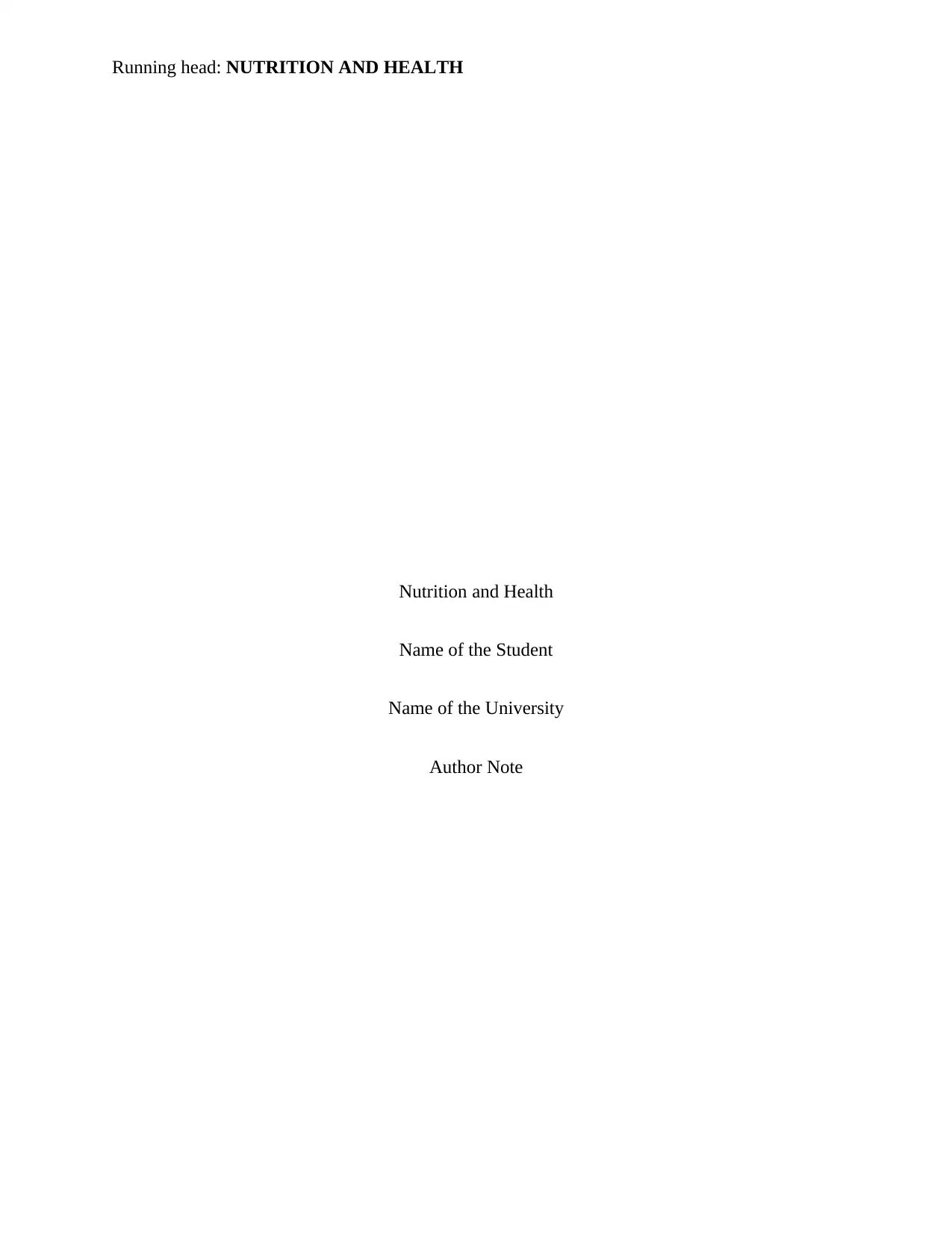
Running head: NUTRITION AND HEALTH
Nutrition and Health
Name of the Student
Name of the University
Author Note
Nutrition and Health
Name of the Student
Name of the University
Author Note
Paraphrase This Document
Need a fresh take? Get an instant paraphrase of this document with our AI Paraphraser
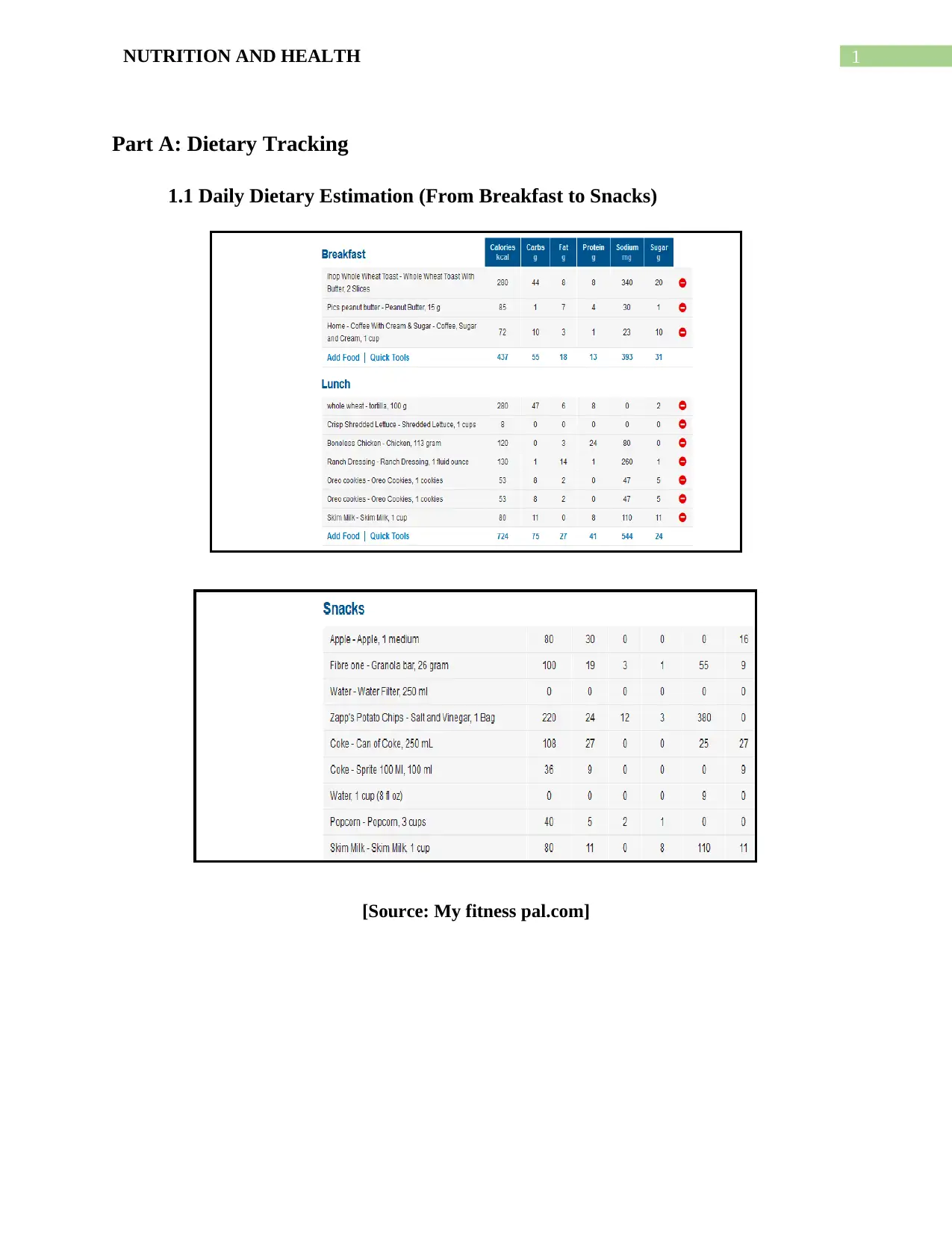
1NUTRITION AND HEALTH
Part A: Dietary Tracking
1.1 Daily Dietary Estimation (From Breakfast to Snacks)
[Source: My fitness pal.com]
Part A: Dietary Tracking
1.1 Daily Dietary Estimation (From Breakfast to Snacks)
[Source: My fitness pal.com]
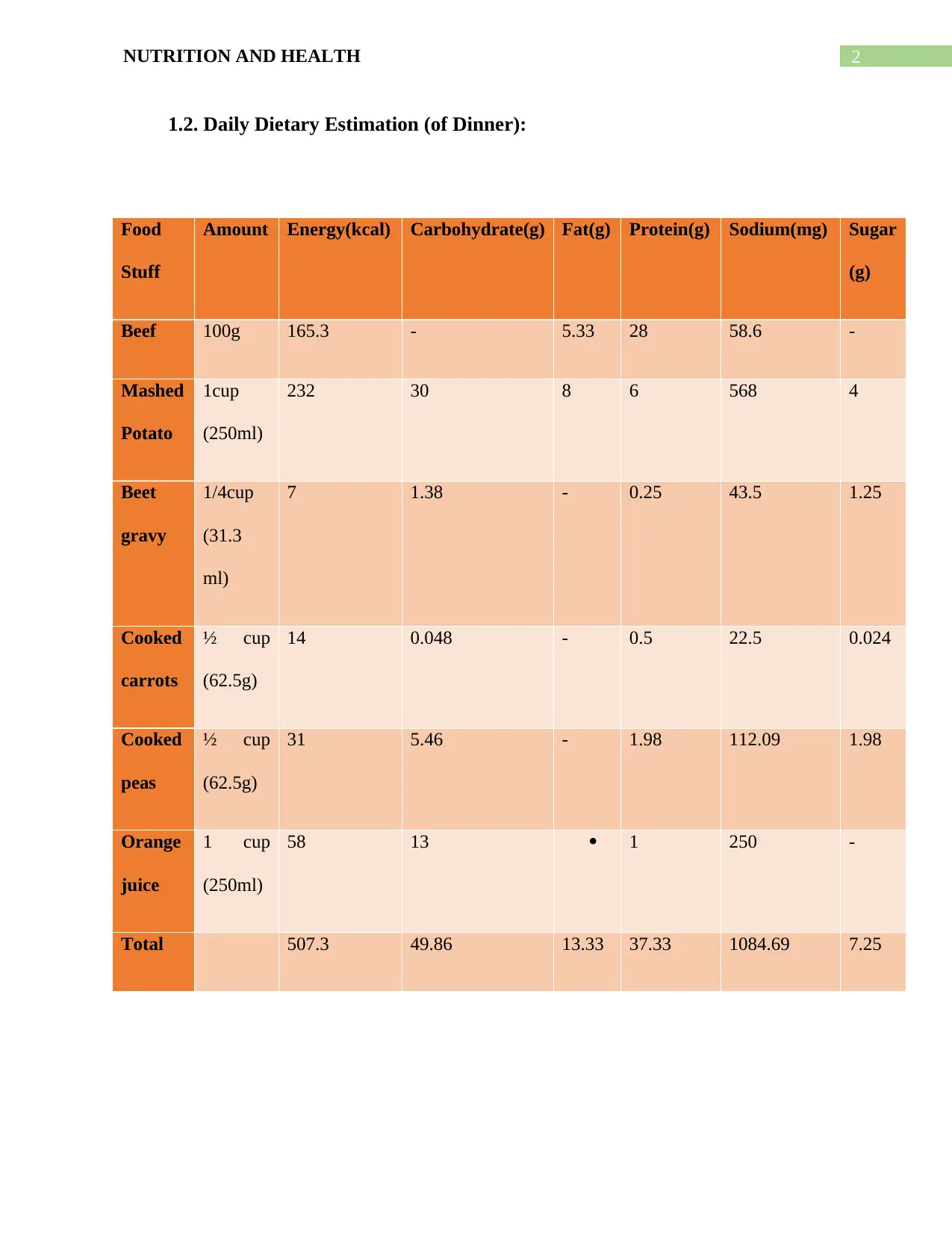
2NUTRITION AND HEALTH
1.2. Daily Dietary Estimation (of Dinner):
Food
Stuff
Amount Energy(kcal) Carbohydrate(g) Fat(g) Protein(g) Sodium(mg) Sugar
(g)
Beef 100g 165.3 - 5.33 28 58.6 -
Mashed
Potato
1cup
(250ml)
232 30 8 6 568 4
Beet
gravy
1/4cup
(31.3
ml)
7 1.38 - 0.25 43.5 1.25
Cooked
carrots
½ cup
(62.5g)
14 0.048 - 0.5 22.5 0.024
Cooked
peas
½ cup
(62.5g)
31 5.46 - 1.98 112.09 1.98
Orange
juice
1 cup
(250ml)
58 13 1 250 -
Total 507.3 49.86 13.33 37.33 1084.69 7.25
1.2. Daily Dietary Estimation (of Dinner):
Food
Stuff
Amount Energy(kcal) Carbohydrate(g) Fat(g) Protein(g) Sodium(mg) Sugar
(g)
Beef 100g 165.3 - 5.33 28 58.6 -
Mashed
Potato
1cup
(250ml)
232 30 8 6 568 4
Beet
gravy
1/4cup
(31.3
ml)
7 1.38 - 0.25 43.5 1.25
Cooked
carrots
½ cup
(62.5g)
14 0.048 - 0.5 22.5 0.024
Cooked
peas
½ cup
(62.5g)
31 5.46 - 1.98 112.09 1.98
Orange
juice
1 cup
(250ml)
58 13 1 250 -
Total 507.3 49.86 13.33 37.33 1084.69 7.25
⊘ This is a preview!⊘
Do you want full access?
Subscribe today to unlock all pages.

Trusted by 1+ million students worldwide
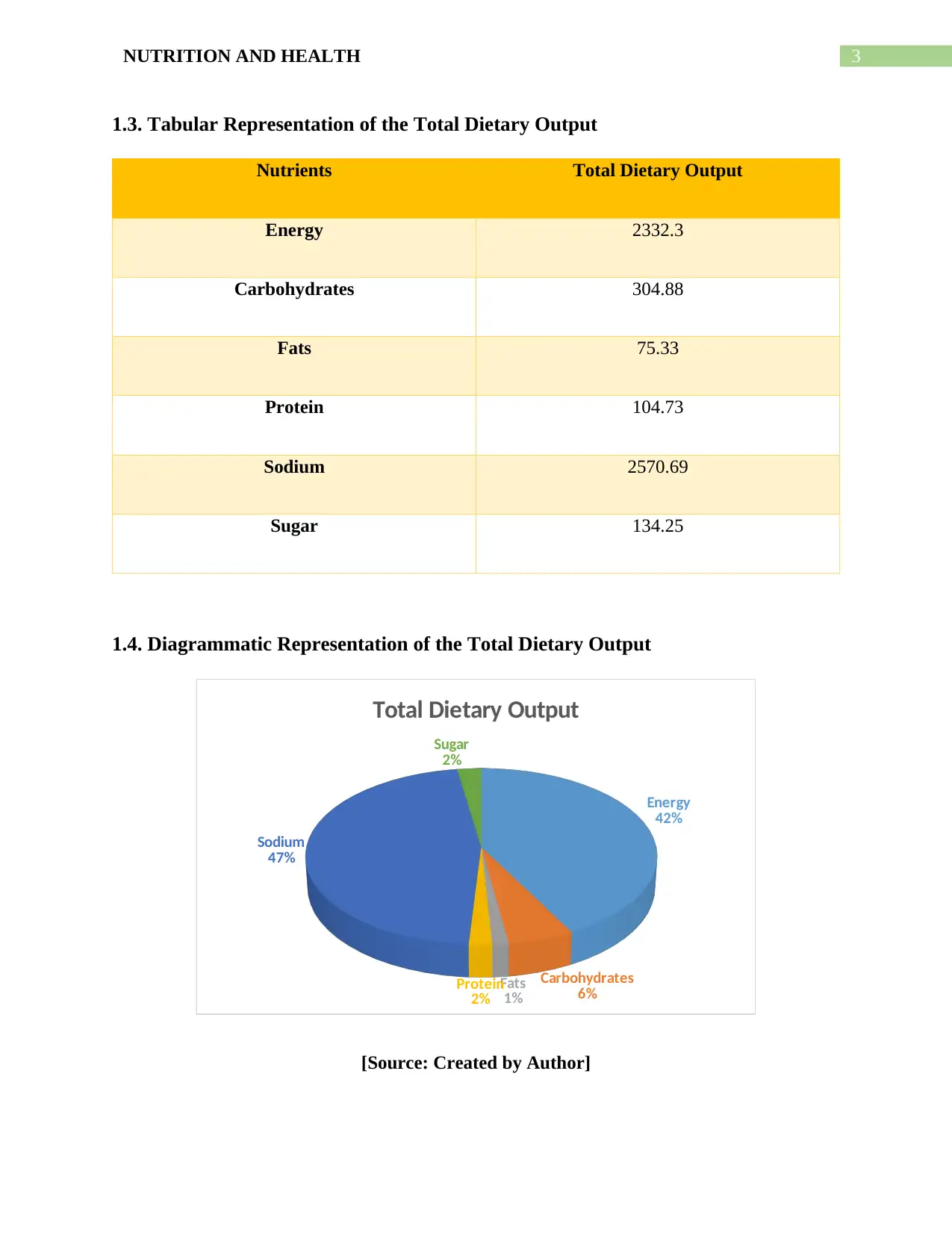
3NUTRITION AND HEALTH
1.3. Tabular Representation of the Total Dietary Output
Nutrients Total Dietary Output
Energy 2332.3
Carbohydrates 304.88
Fats 75.33
Protein 104.73
Sodium 2570.69
Sugar 134.25
1.4. Diagrammatic Representation of the Total Dietary Output
Energy
42%
Carbohydrates
6%
Fats
1%
Protein
2%
Sodium
47%
Sugar
2%
Total Dietary Output
[Source: Created by Author]
1.3. Tabular Representation of the Total Dietary Output
Nutrients Total Dietary Output
Energy 2332.3
Carbohydrates 304.88
Fats 75.33
Protein 104.73
Sodium 2570.69
Sugar 134.25
1.4. Diagrammatic Representation of the Total Dietary Output
Energy
42%
Carbohydrates
6%
Fats
1%
Protein
2%
Sodium
47%
Sugar
2%
Total Dietary Output
[Source: Created by Author]
Paraphrase This Document
Need a fresh take? Get an instant paraphrase of this document with our AI Paraphraser
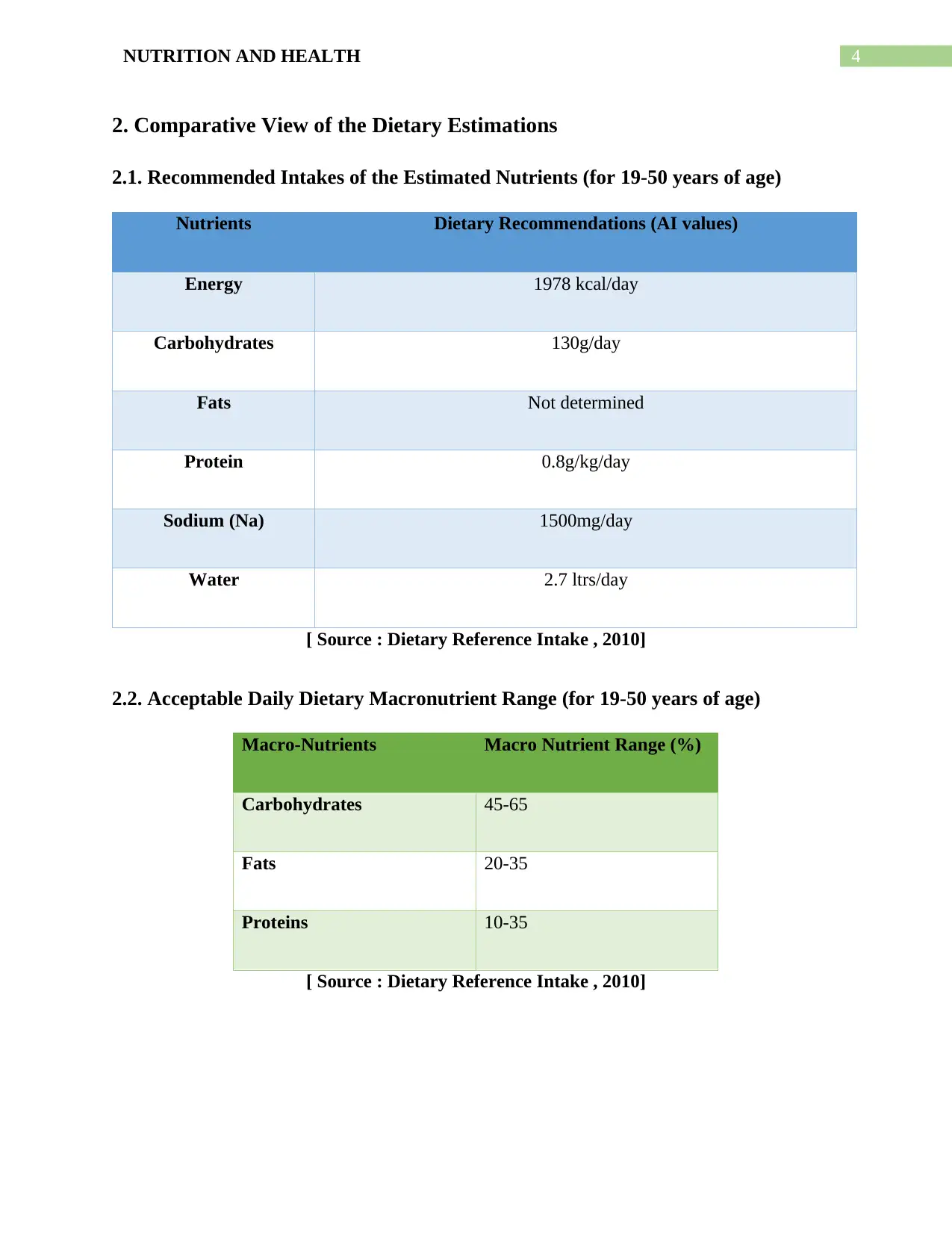
4NUTRITION AND HEALTH
2. Comparative View of the Dietary Estimations
2.1. Recommended Intakes of the Estimated Nutrients (for 19-50 years of age)
Nutrients Dietary Recommendations (AI values)
Energy 1978 kcal/day
Carbohydrates 130g/day
Fats Not determined
Protein 0.8g/kg/day
Sodium (Na) 1500mg/day
Water 2.7 ltrs/day
[ Source : Dietary Reference Intake , 2010]
2.2. Acceptable Daily Dietary Macronutrient Range (for 19-50 years of age)
Macro-Nutrients Macro Nutrient Range (%)
Carbohydrates 45-65
Fats 20-35
Proteins 10-35
[ Source : Dietary Reference Intake , 2010]
2. Comparative View of the Dietary Estimations
2.1. Recommended Intakes of the Estimated Nutrients (for 19-50 years of age)
Nutrients Dietary Recommendations (AI values)
Energy 1978 kcal/day
Carbohydrates 130g/day
Fats Not determined
Protein 0.8g/kg/day
Sodium (Na) 1500mg/day
Water 2.7 ltrs/day
[ Source : Dietary Reference Intake , 2010]
2.2. Acceptable Daily Dietary Macronutrient Range (for 19-50 years of age)
Macro-Nutrients Macro Nutrient Range (%)
Carbohydrates 45-65
Fats 20-35
Proteins 10-35
[ Source : Dietary Reference Intake , 2010]
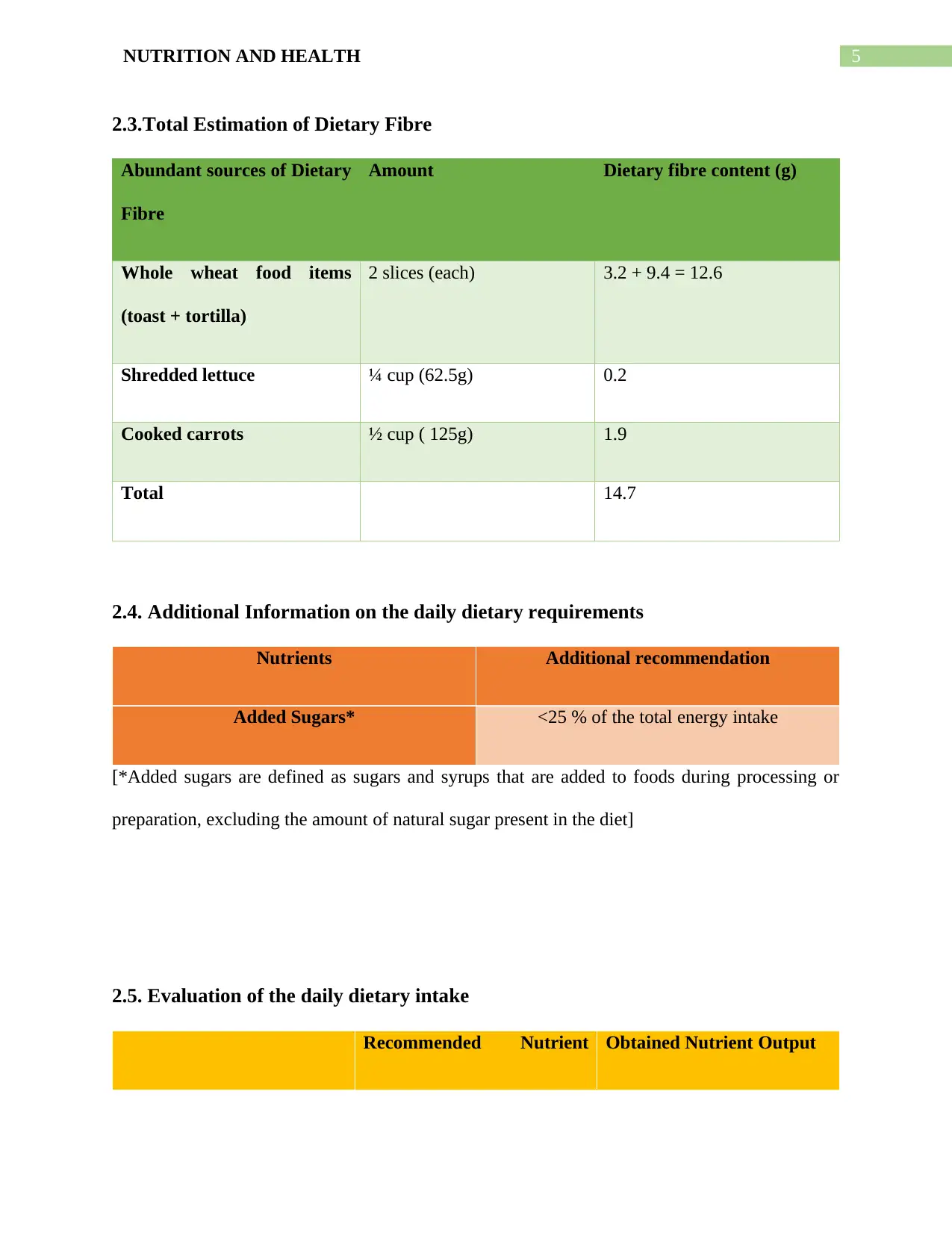
5NUTRITION AND HEALTH
2.3.Total Estimation of Dietary Fibre
Abundant sources of Dietary
Fibre
Amount Dietary fibre content (g)
Whole wheat food items
(toast + tortilla)
2 slices (each) 3.2 + 9.4 = 12.6
Shredded lettuce ¼ cup (62.5g) 0.2
Cooked carrots ½ cup ( 125g) 1.9
Total 14.7
2.4. Additional Information on the daily dietary requirements
Nutrients Additional recommendation
Added Sugars* <25 % of the total energy intake
[*Added sugars are defined as sugars and syrups that are added to foods during processing or
preparation, excluding the amount of natural sugar present in the diet]
2.5. Evaluation of the daily dietary intake
Recommended Nutrient Obtained Nutrient Output
2.3.Total Estimation of Dietary Fibre
Abundant sources of Dietary
Fibre
Amount Dietary fibre content (g)
Whole wheat food items
(toast + tortilla)
2 slices (each) 3.2 + 9.4 = 12.6
Shredded lettuce ¼ cup (62.5g) 0.2
Cooked carrots ½ cup ( 125g) 1.9
Total 14.7
2.4. Additional Information on the daily dietary requirements
Nutrients Additional recommendation
Added Sugars* <25 % of the total energy intake
[*Added sugars are defined as sugars and syrups that are added to foods during processing or
preparation, excluding the amount of natural sugar present in the diet]
2.5. Evaluation of the daily dietary intake
Recommended Nutrient Obtained Nutrient Output
⊘ This is a preview!⊘
Do you want full access?
Subscribe today to unlock all pages.

Trusted by 1+ million students worldwide
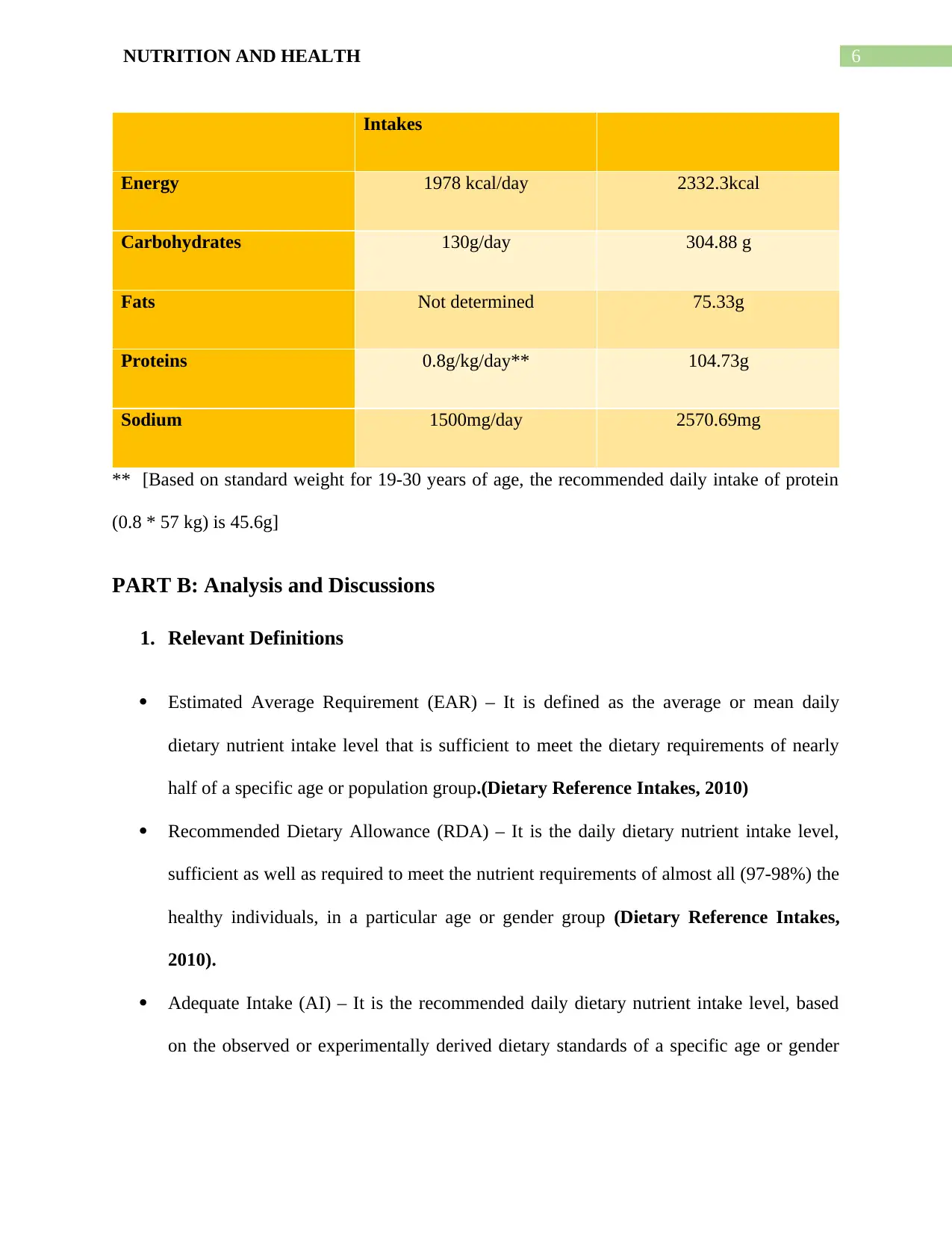
6NUTRITION AND HEALTH
Intakes
Energy 1978 kcal/day 2332.3kcal
Carbohydrates 130g/day 304.88 g
Fats Not determined 75.33g
Proteins 0.8g/kg/day** 104.73g
Sodium 1500mg/day 2570.69mg
** [Based on standard weight for 19-30 years of age, the recommended daily intake of protein
(0.8 * 57 kg) is 45.6g]
PART B: Analysis and Discussions
1. Relevant Definitions
Estimated Average Requirement (EAR) – It is defined as the average or mean daily
dietary nutrient intake level that is sufficient to meet the dietary requirements of nearly
half of a specific age or population group.(Dietary Reference Intakes, 2010)
Recommended Dietary Allowance (RDA) – It is the daily dietary nutrient intake level,
sufficient as well as required to meet the nutrient requirements of almost all (97-98%) the
healthy individuals, in a particular age or gender group (Dietary Reference Intakes,
2010).
Adequate Intake (AI) – It is the recommended daily dietary nutrient intake level, based
on the observed or experimentally derived dietary standards of a specific age or gender
Intakes
Energy 1978 kcal/day 2332.3kcal
Carbohydrates 130g/day 304.88 g
Fats Not determined 75.33g
Proteins 0.8g/kg/day** 104.73g
Sodium 1500mg/day 2570.69mg
** [Based on standard weight for 19-30 years of age, the recommended daily intake of protein
(0.8 * 57 kg) is 45.6g]
PART B: Analysis and Discussions
1. Relevant Definitions
Estimated Average Requirement (EAR) – It is defined as the average or mean daily
dietary nutrient intake level that is sufficient to meet the dietary requirements of nearly
half of a specific age or population group.(Dietary Reference Intakes, 2010)
Recommended Dietary Allowance (RDA) – It is the daily dietary nutrient intake level,
sufficient as well as required to meet the nutrient requirements of almost all (97-98%) the
healthy individuals, in a particular age or gender group (Dietary Reference Intakes,
2010).
Adequate Intake (AI) – It is the recommended daily dietary nutrient intake level, based
on the observed or experimentally derived dietary standards of a specific age or gender
Paraphrase This Document
Need a fresh take? Get an instant paraphrase of this document with our AI Paraphraser
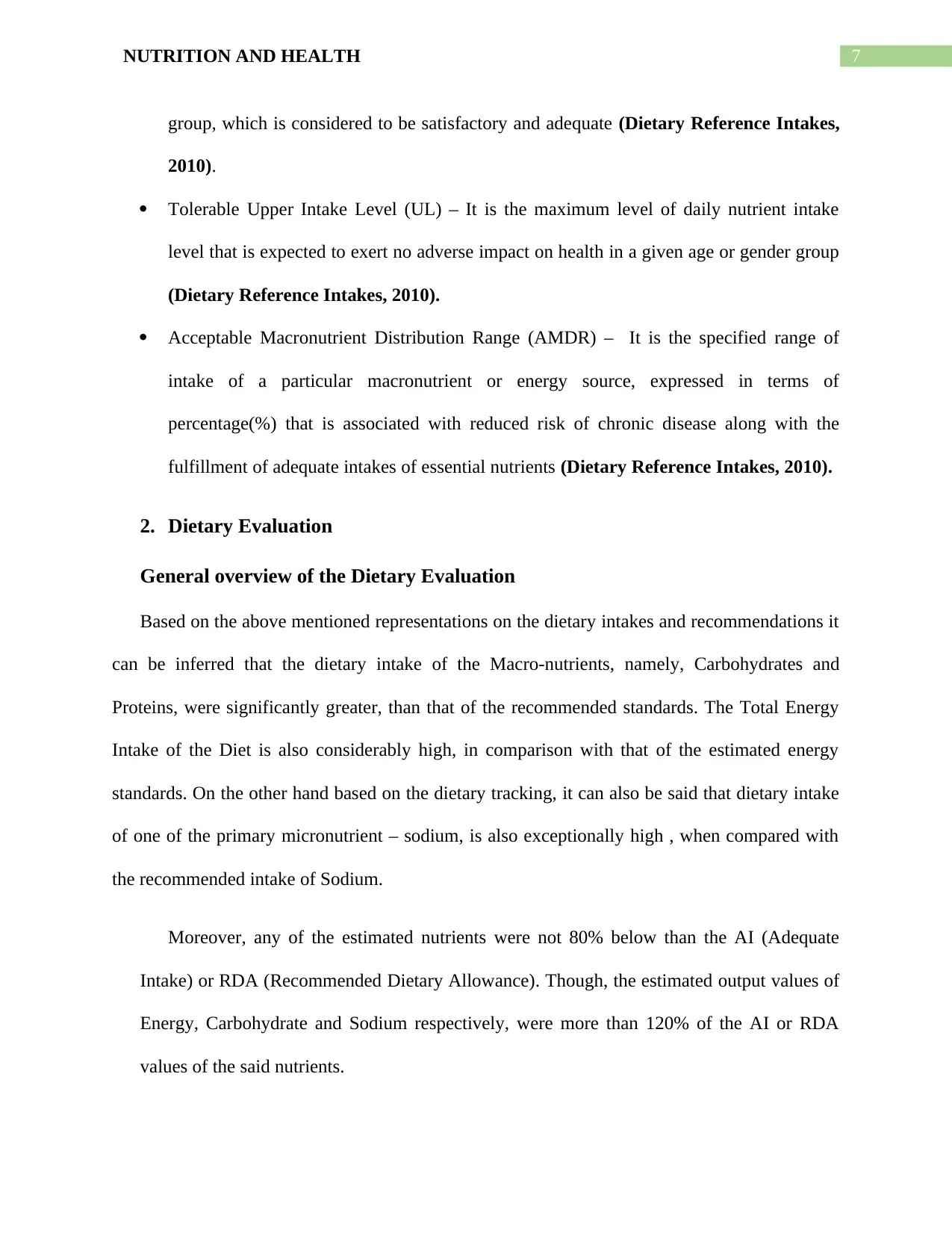
7NUTRITION AND HEALTH
group, which is considered to be satisfactory and adequate (Dietary Reference Intakes,
2010).
Tolerable Upper Intake Level (UL) – It is the maximum level of daily nutrient intake
level that is expected to exert no adverse impact on health in a given age or gender group
(Dietary Reference Intakes, 2010).
Acceptable Macronutrient Distribution Range (AMDR) – It is the specified range of
intake of a particular macronutrient or energy source, expressed in terms of
percentage(%) that is associated with reduced risk of chronic disease along with the
fulfillment of adequate intakes of essential nutrients (Dietary Reference Intakes, 2010).
2. Dietary Evaluation
General overview of the Dietary Evaluation
Based on the above mentioned representations on the dietary intakes and recommendations it
can be inferred that the dietary intake of the Macro-nutrients, namely, Carbohydrates and
Proteins, were significantly greater, than that of the recommended standards. The Total Energy
Intake of the Diet is also considerably high, in comparison with that of the estimated energy
standards. On the other hand based on the dietary tracking, it can also be said that dietary intake
of one of the primary micronutrient – sodium, is also exceptionally high , when compared with
the recommended intake of Sodium.
Moreover, any of the estimated nutrients were not 80% below than the AI (Adequate
Intake) or RDA (Recommended Dietary Allowance). Though, the estimated output values of
Energy, Carbohydrate and Sodium respectively, were more than 120% of the AI or RDA
values of the said nutrients.
group, which is considered to be satisfactory and adequate (Dietary Reference Intakes,
2010).
Tolerable Upper Intake Level (UL) – It is the maximum level of daily nutrient intake
level that is expected to exert no adverse impact on health in a given age or gender group
(Dietary Reference Intakes, 2010).
Acceptable Macronutrient Distribution Range (AMDR) – It is the specified range of
intake of a particular macronutrient or energy source, expressed in terms of
percentage(%) that is associated with reduced risk of chronic disease along with the
fulfillment of adequate intakes of essential nutrients (Dietary Reference Intakes, 2010).
2. Dietary Evaluation
General overview of the Dietary Evaluation
Based on the above mentioned representations on the dietary intakes and recommendations it
can be inferred that the dietary intake of the Macro-nutrients, namely, Carbohydrates and
Proteins, were significantly greater, than that of the recommended standards. The Total Energy
Intake of the Diet is also considerably high, in comparison with that of the estimated energy
standards. On the other hand based on the dietary tracking, it can also be said that dietary intake
of one of the primary micronutrient – sodium, is also exceptionally high , when compared with
the recommended intake of Sodium.
Moreover, any of the estimated nutrients were not 80% below than the AI (Adequate
Intake) or RDA (Recommended Dietary Allowance). Though, the estimated output values of
Energy, Carbohydrate and Sodium respectively, were more than 120% of the AI or RDA
values of the said nutrients.
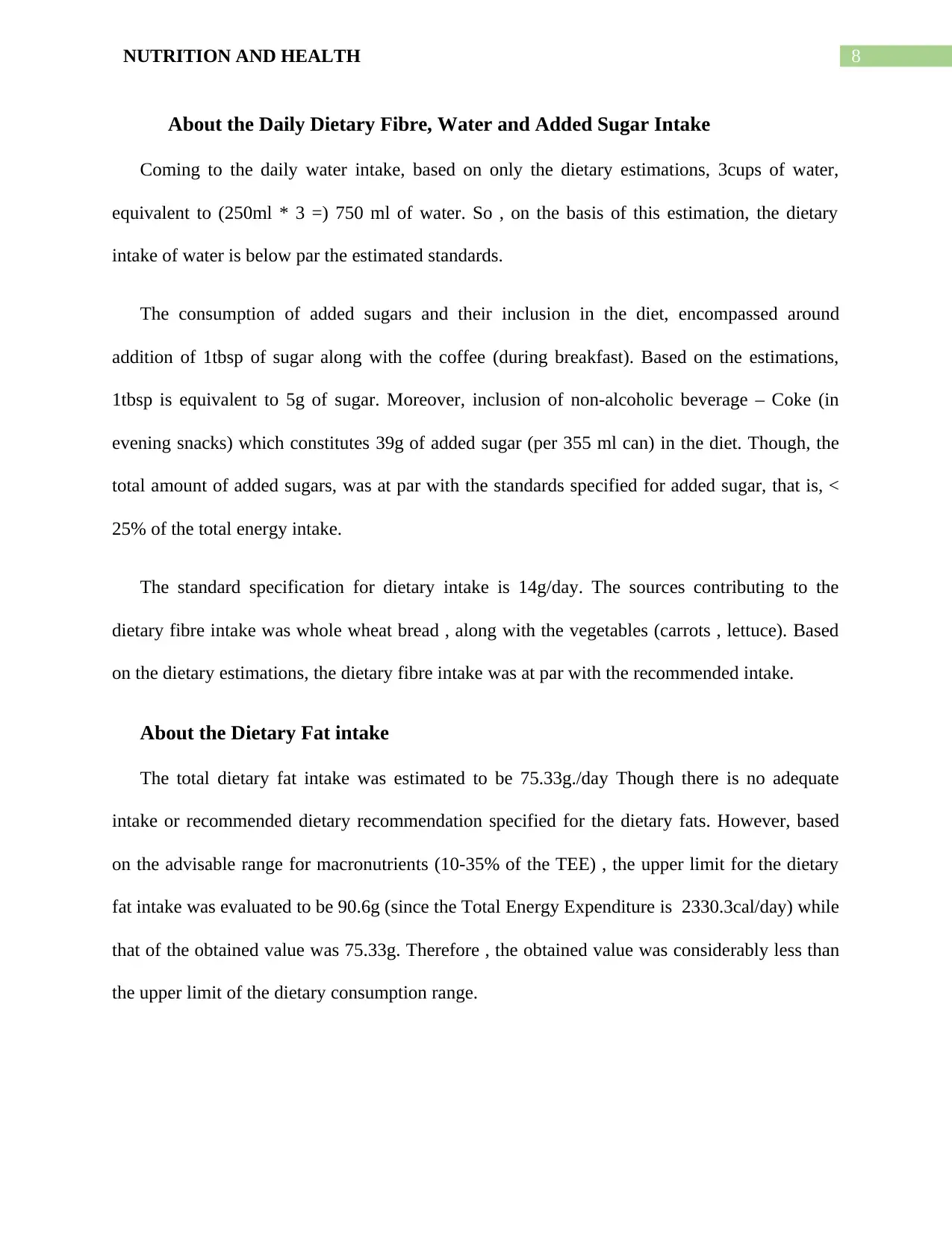
8NUTRITION AND HEALTH
About the Daily Dietary Fibre, Water and Added Sugar Intake
Coming to the daily water intake, based on only the dietary estimations, 3cups of water,
equivalent to (250ml * 3 =) 750 ml of water. So , on the basis of this estimation, the dietary
intake of water is below par the estimated standards.
The consumption of added sugars and their inclusion in the diet, encompassed around
addition of 1tbsp of sugar along with the coffee (during breakfast). Based on the estimations,
1tbsp is equivalent to 5g of sugar. Moreover, inclusion of non-alcoholic beverage – Coke (in
evening snacks) which constitutes 39g of added sugar (per 355 ml can) in the diet. Though, the
total amount of added sugars, was at par with the standards specified for added sugar, that is, <
25% of the total energy intake.
The standard specification for dietary intake is 14g/day. The sources contributing to the
dietary fibre intake was whole wheat bread , along with the vegetables (carrots , lettuce). Based
on the dietary estimations, the dietary fibre intake was at par with the recommended intake.
About the Dietary Fat intake
The total dietary fat intake was estimated to be 75.33g./day Though there is no adequate
intake or recommended dietary recommendation specified for the dietary fats. However, based
on the advisable range for macronutrients (10-35% of the TEE) , the upper limit for the dietary
fat intake was evaluated to be 90.6g (since the Total Energy Expenditure is 2330.3cal/day) while
that of the obtained value was 75.33g. Therefore , the obtained value was considerably less than
the upper limit of the dietary consumption range.
About the Daily Dietary Fibre, Water and Added Sugar Intake
Coming to the daily water intake, based on only the dietary estimations, 3cups of water,
equivalent to (250ml * 3 =) 750 ml of water. So , on the basis of this estimation, the dietary
intake of water is below par the estimated standards.
The consumption of added sugars and their inclusion in the diet, encompassed around
addition of 1tbsp of sugar along with the coffee (during breakfast). Based on the estimations,
1tbsp is equivalent to 5g of sugar. Moreover, inclusion of non-alcoholic beverage – Coke (in
evening snacks) which constitutes 39g of added sugar (per 355 ml can) in the diet. Though, the
total amount of added sugars, was at par with the standards specified for added sugar, that is, <
25% of the total energy intake.
The standard specification for dietary intake is 14g/day. The sources contributing to the
dietary fibre intake was whole wheat bread , along with the vegetables (carrots , lettuce). Based
on the dietary estimations, the dietary fibre intake was at par with the recommended intake.
About the Dietary Fat intake
The total dietary fat intake was estimated to be 75.33g./day Though there is no adequate
intake or recommended dietary recommendation specified for the dietary fats. However, based
on the advisable range for macronutrients (10-35% of the TEE) , the upper limit for the dietary
fat intake was evaluated to be 90.6g (since the Total Energy Expenditure is 2330.3cal/day) while
that of the obtained value was 75.33g. Therefore , the obtained value was considerably less than
the upper limit of the dietary consumption range.
⊘ This is a preview!⊘
Do you want full access?
Subscribe today to unlock all pages.

Trusted by 1+ million students worldwide
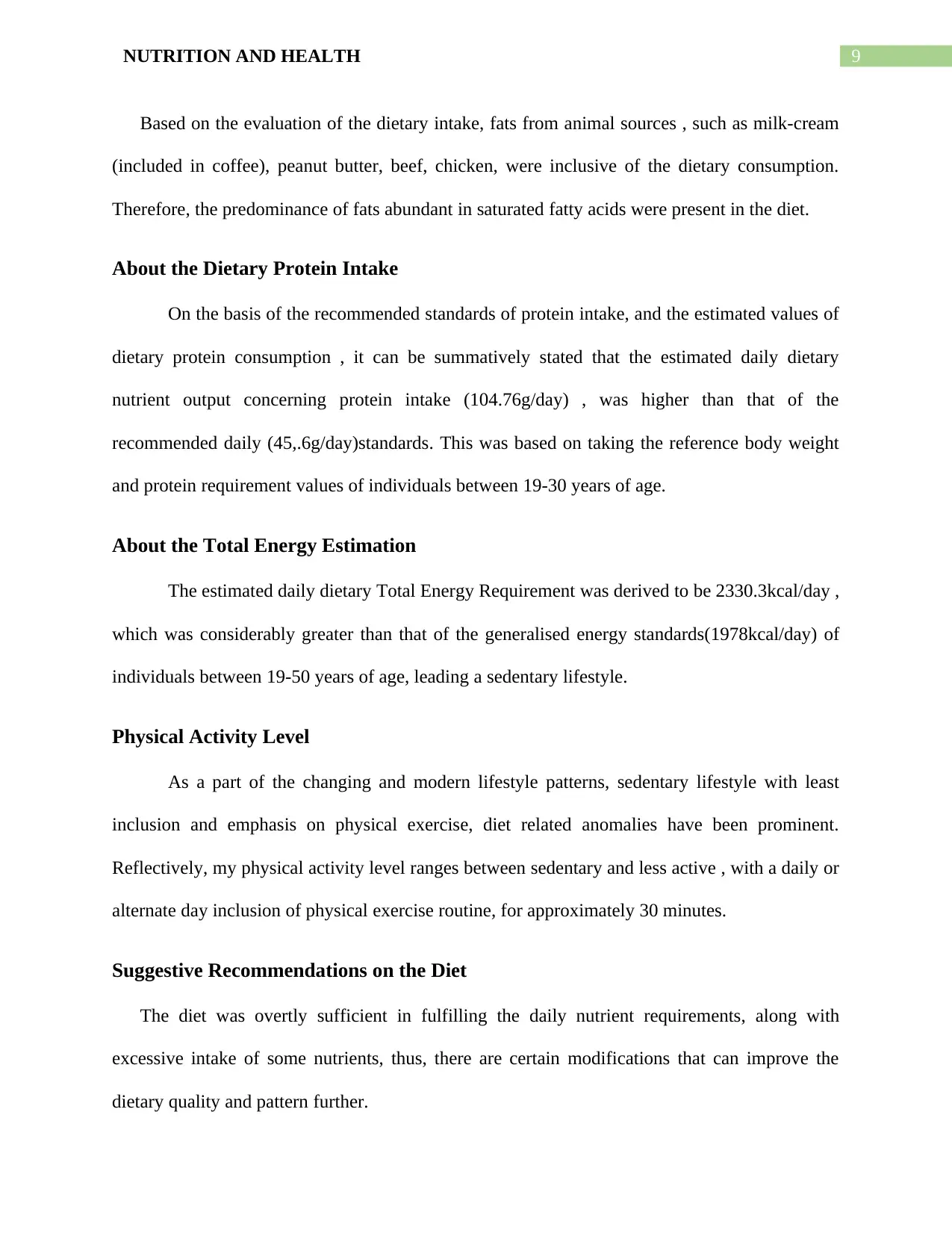
9NUTRITION AND HEALTH
Based on the evaluation of the dietary intake, fats from animal sources , such as milk-cream
(included in coffee), peanut butter, beef, chicken, were inclusive of the dietary consumption.
Therefore, the predominance of fats abundant in saturated fatty acids were present in the diet.
About the Dietary Protein Intake
On the basis of the recommended standards of protein intake, and the estimated values of
dietary protein consumption , it can be summatively stated that the estimated daily dietary
nutrient output concerning protein intake (104.76g/day) , was higher than that of the
recommended daily (45,.6g/day)standards. This was based on taking the reference body weight
and protein requirement values of individuals between 19-30 years of age.
About the Total Energy Estimation
The estimated daily dietary Total Energy Requirement was derived to be 2330.3kcal/day ,
which was considerably greater than that of the generalised energy standards(1978kcal/day) of
individuals between 19-50 years of age, leading a sedentary lifestyle.
Physical Activity Level
As a part of the changing and modern lifestyle patterns, sedentary lifestyle with least
inclusion and emphasis on physical exercise, diet related anomalies have been prominent.
Reflectively, my physical activity level ranges between sedentary and less active , with a daily or
alternate day inclusion of physical exercise routine, for approximately 30 minutes.
Suggestive Recommendations on the Diet
The diet was overtly sufficient in fulfilling the daily nutrient requirements, along with
excessive intake of some nutrients, thus, there are certain modifications that can improve the
dietary quality and pattern further.
Based on the evaluation of the dietary intake, fats from animal sources , such as milk-cream
(included in coffee), peanut butter, beef, chicken, were inclusive of the dietary consumption.
Therefore, the predominance of fats abundant in saturated fatty acids were present in the diet.
About the Dietary Protein Intake
On the basis of the recommended standards of protein intake, and the estimated values of
dietary protein consumption , it can be summatively stated that the estimated daily dietary
nutrient output concerning protein intake (104.76g/day) , was higher than that of the
recommended daily (45,.6g/day)standards. This was based on taking the reference body weight
and protein requirement values of individuals between 19-30 years of age.
About the Total Energy Estimation
The estimated daily dietary Total Energy Requirement was derived to be 2330.3kcal/day ,
which was considerably greater than that of the generalised energy standards(1978kcal/day) of
individuals between 19-50 years of age, leading a sedentary lifestyle.
Physical Activity Level
As a part of the changing and modern lifestyle patterns, sedentary lifestyle with least
inclusion and emphasis on physical exercise, diet related anomalies have been prominent.
Reflectively, my physical activity level ranges between sedentary and less active , with a daily or
alternate day inclusion of physical exercise routine, for approximately 30 minutes.
Suggestive Recommendations on the Diet
The diet was overtly sufficient in fulfilling the daily nutrient requirements, along with
excessive intake of some nutrients, thus, there are certain modifications that can improve the
dietary quality and pattern further.
Paraphrase This Document
Need a fresh take? Get an instant paraphrase of this document with our AI Paraphraser
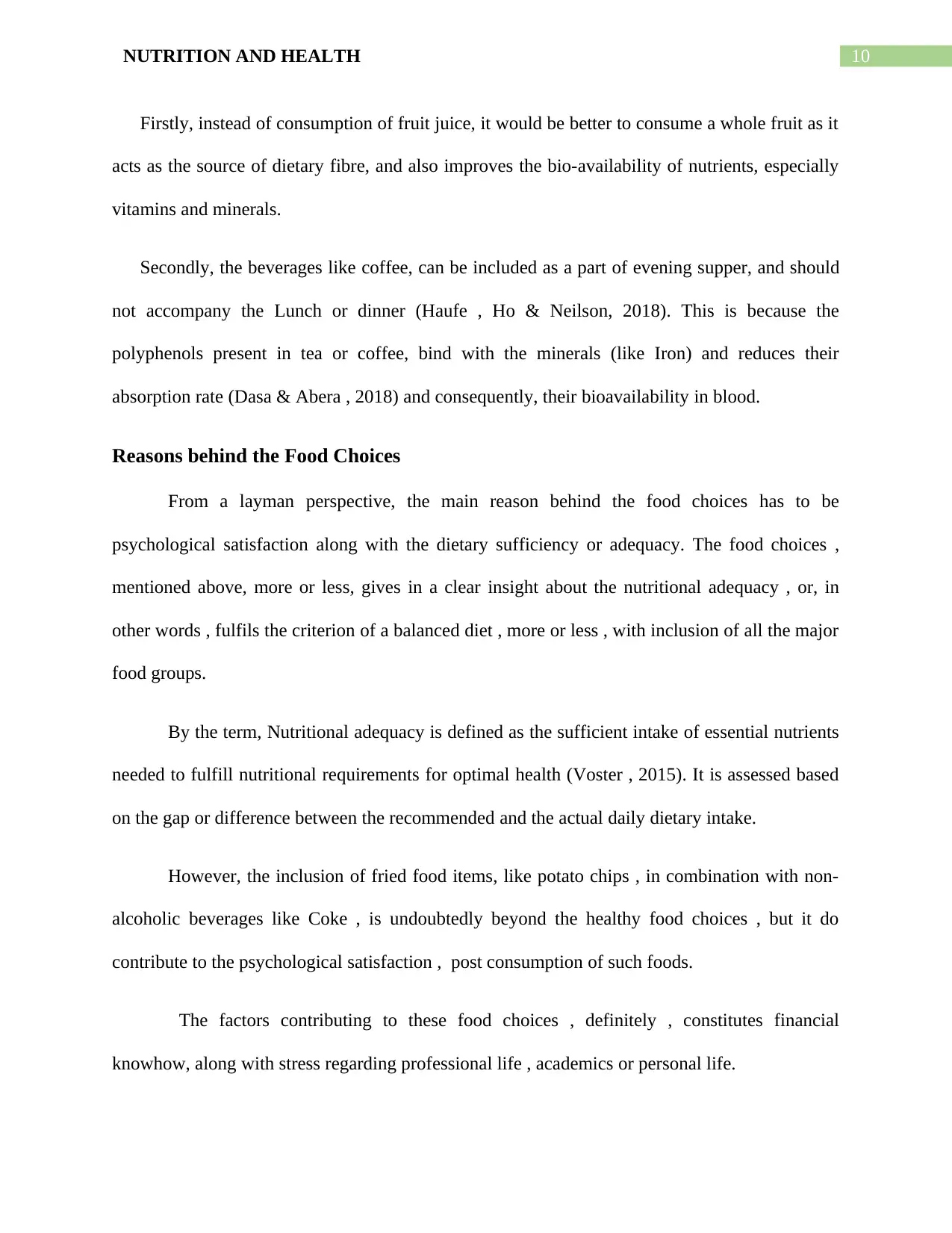
10NUTRITION AND HEALTH
Firstly, instead of consumption of fruit juice, it would be better to consume a whole fruit as it
acts as the source of dietary fibre, and also improves the bio-availability of nutrients, especially
vitamins and minerals.
Secondly, the beverages like coffee, can be included as a part of evening supper, and should
not accompany the Lunch or dinner (Haufe , Ho & Neilson, 2018). This is because the
polyphenols present in tea or coffee, bind with the minerals (like Iron) and reduces their
absorption rate (Dasa & Abera , 2018) and consequently, their bioavailability in blood.
Reasons behind the Food Choices
From a layman perspective, the main reason behind the food choices has to be
psychological satisfaction along with the dietary sufficiency or adequacy. The food choices ,
mentioned above, more or less, gives in a clear insight about the nutritional adequacy , or, in
other words , fulfils the criterion of a balanced diet , more or less , with inclusion of all the major
food groups.
By the term, Nutritional adequacy is defined as the sufficient intake of essential nutrients
needed to fulfill nutritional requirements for optimal health (Voster , 2015). It is assessed based
on the gap or difference between the recommended and the actual daily dietary intake.
However, the inclusion of fried food items, like potato chips , in combination with non-
alcoholic beverages like Coke , is undoubtedly beyond the healthy food choices , but it do
contribute to the psychological satisfaction , post consumption of such foods.
The factors contributing to these food choices , definitely , constitutes financial
knowhow, along with stress regarding professional life , academics or personal life.
Firstly, instead of consumption of fruit juice, it would be better to consume a whole fruit as it
acts as the source of dietary fibre, and also improves the bio-availability of nutrients, especially
vitamins and minerals.
Secondly, the beverages like coffee, can be included as a part of evening supper, and should
not accompany the Lunch or dinner (Haufe , Ho & Neilson, 2018). This is because the
polyphenols present in tea or coffee, bind with the minerals (like Iron) and reduces their
absorption rate (Dasa & Abera , 2018) and consequently, their bioavailability in blood.
Reasons behind the Food Choices
From a layman perspective, the main reason behind the food choices has to be
psychological satisfaction along with the dietary sufficiency or adequacy. The food choices ,
mentioned above, more or less, gives in a clear insight about the nutritional adequacy , or, in
other words , fulfils the criterion of a balanced diet , more or less , with inclusion of all the major
food groups.
By the term, Nutritional adequacy is defined as the sufficient intake of essential nutrients
needed to fulfill nutritional requirements for optimal health (Voster , 2015). It is assessed based
on the gap or difference between the recommended and the actual daily dietary intake.
However, the inclusion of fried food items, like potato chips , in combination with non-
alcoholic beverages like Coke , is undoubtedly beyond the healthy food choices , but it do
contribute to the psychological satisfaction , post consumption of such foods.
The factors contributing to these food choices , definitely , constitutes financial
knowhow, along with stress regarding professional life , academics or personal life.
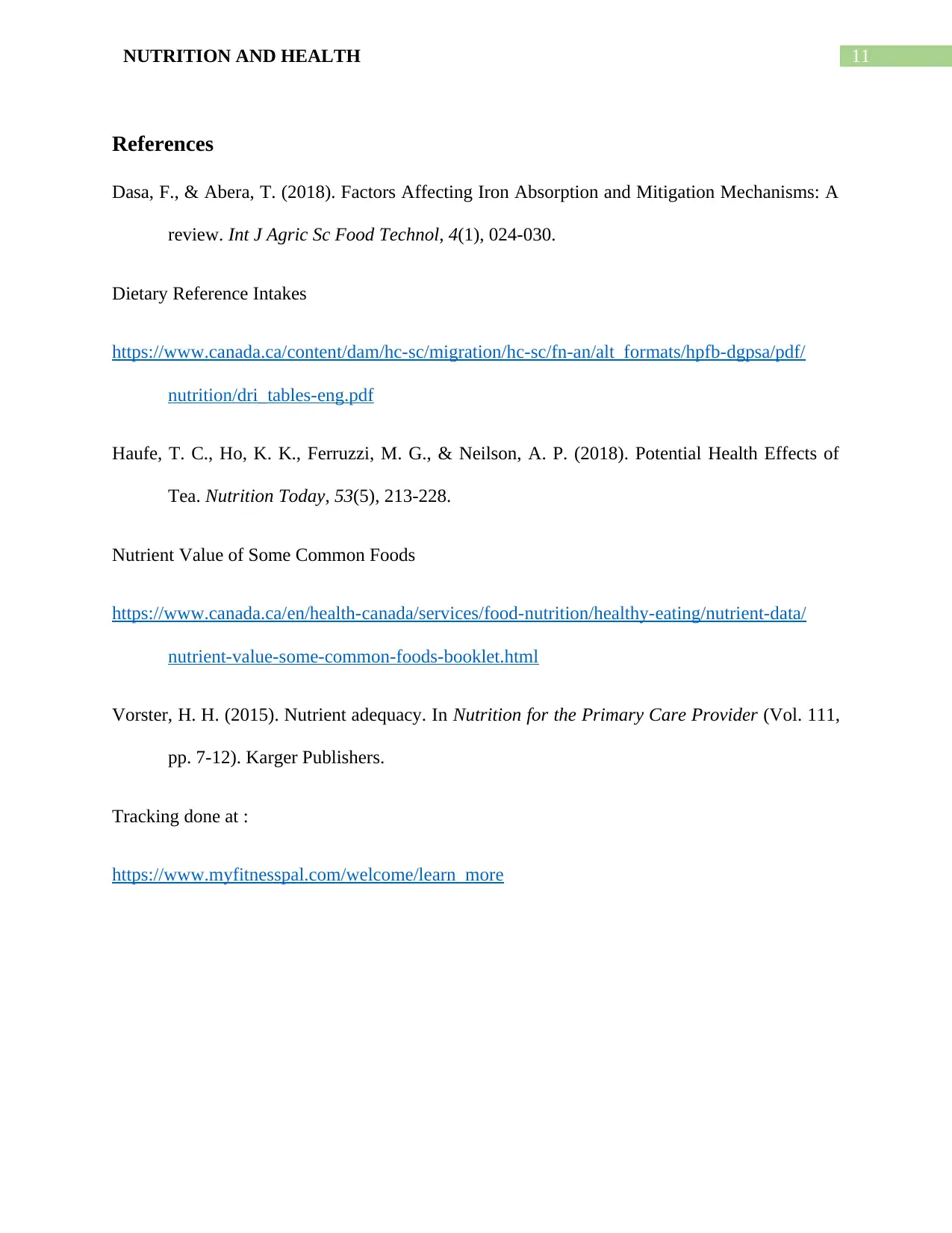
11NUTRITION AND HEALTH
References
Dasa, F., & Abera, T. (2018). Factors Affecting Iron Absorption and Mitigation Mechanisms: A
review. Int J Agric Sc Food Technol, 4(1), 024-030.
Dietary Reference Intakes
https://www.canada.ca/content/dam/hc-sc/migration/hc-sc/fn-an/alt_formats/hpfb-dgpsa/pdf/
nutrition/dri_tables-eng.pdf
Haufe, T. C., Ho, K. K., Ferruzzi, M. G., & Neilson, A. P. (2018). Potential Health Effects of
Tea. Nutrition Today, 53(5), 213-228.
Nutrient Value of Some Common Foods
https://www.canada.ca/en/health-canada/services/food-nutrition/healthy-eating/nutrient-data/
nutrient-value-some-common-foods-booklet.html
Vorster, H. H. (2015). Nutrient adequacy. In Nutrition for the Primary Care Provider (Vol. 111,
pp. 7-12). Karger Publishers.
Tracking done at :
https://www.myfitnesspal.com/welcome/learn_more
References
Dasa, F., & Abera, T. (2018). Factors Affecting Iron Absorption and Mitigation Mechanisms: A
review. Int J Agric Sc Food Technol, 4(1), 024-030.
Dietary Reference Intakes
https://www.canada.ca/content/dam/hc-sc/migration/hc-sc/fn-an/alt_formats/hpfb-dgpsa/pdf/
nutrition/dri_tables-eng.pdf
Haufe, T. C., Ho, K. K., Ferruzzi, M. G., & Neilson, A. P. (2018). Potential Health Effects of
Tea. Nutrition Today, 53(5), 213-228.
Nutrient Value of Some Common Foods
https://www.canada.ca/en/health-canada/services/food-nutrition/healthy-eating/nutrient-data/
nutrient-value-some-common-foods-booklet.html
Vorster, H. H. (2015). Nutrient adequacy. In Nutrition for the Primary Care Provider (Vol. 111,
pp. 7-12). Karger Publishers.
Tracking done at :
https://www.myfitnesspal.com/welcome/learn_more
⊘ This is a preview!⊘
Do you want full access?
Subscribe today to unlock all pages.

Trusted by 1+ million students worldwide
1 out of 12
Related Documents
Your All-in-One AI-Powered Toolkit for Academic Success.
+13062052269
info@desklib.com
Available 24*7 on WhatsApp / Email
![[object Object]](/_next/static/media/star-bottom.7253800d.svg)
Unlock your academic potential
Copyright © 2020–2025 A2Z Services. All Rights Reserved. Developed and managed by ZUCOL.





